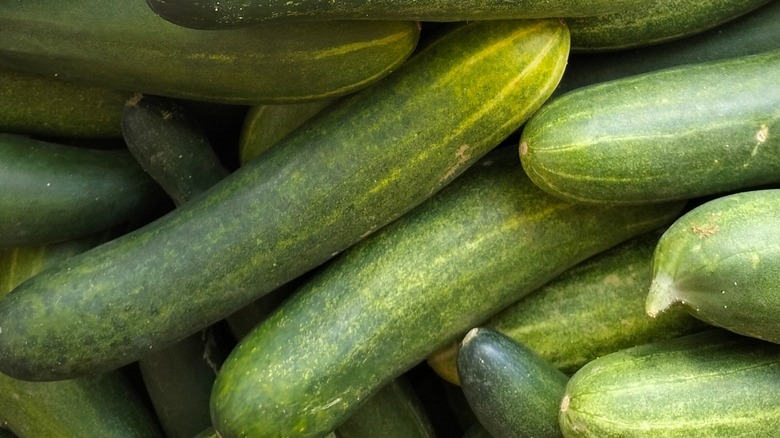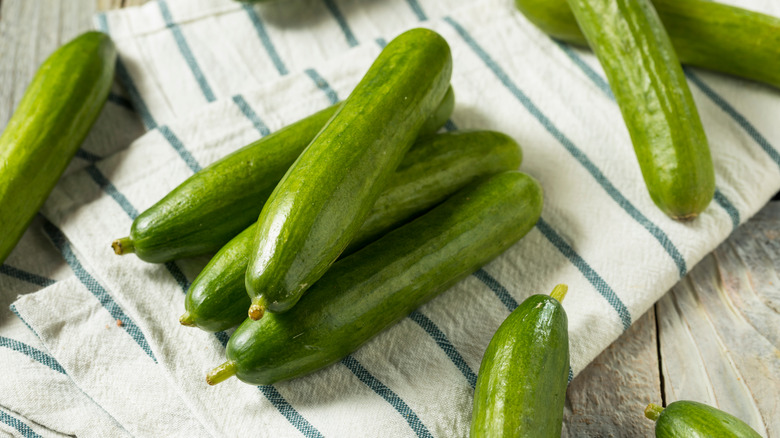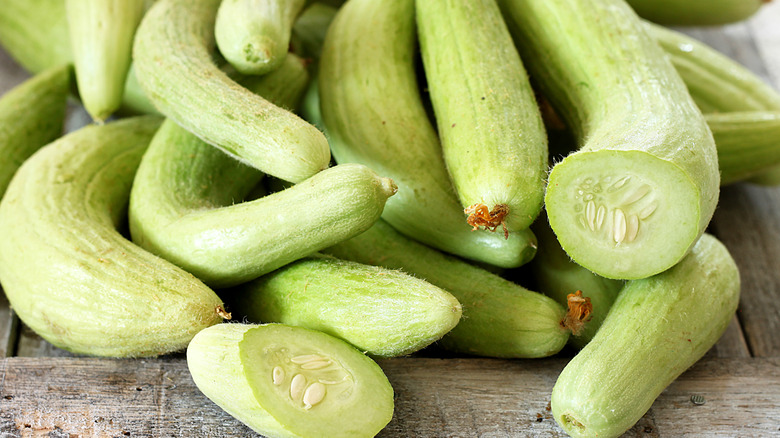A Cheat-Sheet To Grocery Store Cucumbers
Cucumbers are a go-to for fresh salads, easy snacks, and refreshing beverages. They are an affordable way to add bulk and crunch to a whole variety of dishes. Depending on where you shop, you may have access to several different options in varying sizes and shades of green.
In general, cucumbers can be broken down into three different categories: slicing, pickling, and burpless. Though these are not hard and fast rules, slicing cucumbers tend to have thick, dark green skin — while pickling cucumbers usually have thinner skin and are on the shorter side. They also tend to have less moisture than slicers. Burpless cucumbers, also sometimes referred to as seedless, are specifically bred to have less or no bitter compounds called cucurbitacins. There is a mistakenly held belief that cucurbitacins cause gas — hence the name burpless — but that appears to not actually be true. They are however comparatively less bitter than other varieties.
There are a few types of cucumbers that you are more likely to find at a standard supermarket. This cheat sheet is here to help you distinguish between them, and pick the best one for the recipe you have in mind.
Garden cucumbers
Imagine the grocery store produce section, and think of the standard cucumber you are most likely to see — dark green, waxy, and more or less the same size as a big ear of corn. This is a garden cucumber. They are also sometimes referred to as pole cucumbers because they are grown vertically on trellises. These cucumbers tend to have a thick, bitter skin, lots of seeds, and a high water content. For some, these cukes are not considered particularly desirable, but what they lack in flavor they certainly make up for in affordability and dependability. Even out of their usual summer season, you can still find them in abundance.
These cucumbers are not ideal for just skin-on slicing and snacking. Instead, peel them completely. Not only can the skin be bitter, but it also is often coated in wax. Cut the peeled cuke in half lengthwise, and scoop out the seeds with a spoon to help with the watery texture. Pair garden cucumbers with bold flavors and dips. Cut them into spears, and dip them into garlic and jalapeño hummus. You can also toss these cukes with salt, and let them sit in a strainer for about 30 minutes — they will release a good amount of moisture. Then, dress them with a punchy salad dressing, and serve immediately. These cucumbers are not ideal for marinated salads because they will release too much water.
English cucumbers
English cucumbers are also sometimes called hot house, seedless, greenhouse, burpless, or European cucumbers. These are long, slim, and easy to spot since they are usually completely encased in clear plastic. They have delicate flesh, thin skin, and few seeds. The texture is the best part of these cukes — crisp and crunchy. The downside is in the flavor, which is mild bordering on tasteless.
No need to peel these guys. They are great when cut into coins for snacking and dipping, or thinly sliced for sandwiches. Try muddling a couple slices as the base for your favorite gin- or vodka-based cocktail, blend them into a smoothie, or make the green juice Martha Stewart drinks every single morning. While English cucumbers do provide delightful texture in leafy green and grain salads, they are not great for long marinades as the flesh is a bit too delicate. Opt for quick-pickling instead, or pack your lunch so that the cucumbers do not come in contact with the dressing until right before serving.
Kirby cucumbers
Kirby cucumbers are your quintessential pickling cucumber. They are short and squat with bumpy skin that ranges from bright yellow to deep green. They are super crunchy and packed with refreshing flavors. The texture and taste can definitely stand up to vinegar, salt, and longer marinating times, which makes them perfect for the pickle jar. But just because they make a great pickle doesn't mean that you can't munch on them raw. Plus, the smaller size means that you can finish a whole cuke usually in one go, so you aren't left with a languishing log in your crisper drawer.
Use kirby cukes in a basic refrigerator pickling recipe, or take a stab at making your own classic canned dill pickles. These are also a great choice if you like to meal prep salads as the firmer texture can hold up to a few days in the fridge.
Persian cucumbers
Persian cucumbers that are commonly available in supermarkets are downright cute. Not more than a few inches long, they often are sold in plastic-wrapped packages of five to six. The diminutive type seems to be the most popular — though you can also sometimes find slightly longer ones. Persian cucumbers have thin skin, hardly any seeds to speak of, and a slightly sweet flavor. These are another variety of burpless cucumbers.
The best quality of Persian cucumbers is the texture of the flesh — it is firm, dense, and crunchy. That makes these cukes ideal for a smashed cucumber salad generously topped with rice vinegar and chili crisp or even quickly cooked at high heat in a stir-fry. Of course, these cucumbers are also a great choice for a lunch or snack to-go. No need to peel or cut — just use the whole cucumber as a dipper. How fun is that?
Fun cucumber varieties
There are actually around 100 different varieties of cucumbers with adorable names like Spacemaster, Sugar Crunch, and Sweet Success. If you regularly shop at a farmers market or specialty store with a great produce selection, you may come across some of these along with more obscure varieties such as silver slicer, lemon cucumbers, and Armenian cucumbers.
Gherkins are pickled baby cucumbers. You may also know them by their French name — cornichons. When these teeny-tiny cucumbers are available fresh in the United States, they may still be labeled as gherkins – though it is much more common to find them already jarred and pickled.
Lemon cucumbers look totally different from many other cucumber varieties. They are round and lemon yellow with plentiful, but innocuous, seeds and good flavor. These can be used in fresh or pickled preparations, and are especially desirable for platter salads, so you can really appreciate the unique look.
The Armenian variety looks like a long, winding, pale green cucumber, but it is actually a type of muskmelon. However, the taste and texture are so similar that you can use them just as you would any other delicate cuke. Stick to fresh preparations with Armenian cucumbers and avoid pickling.






